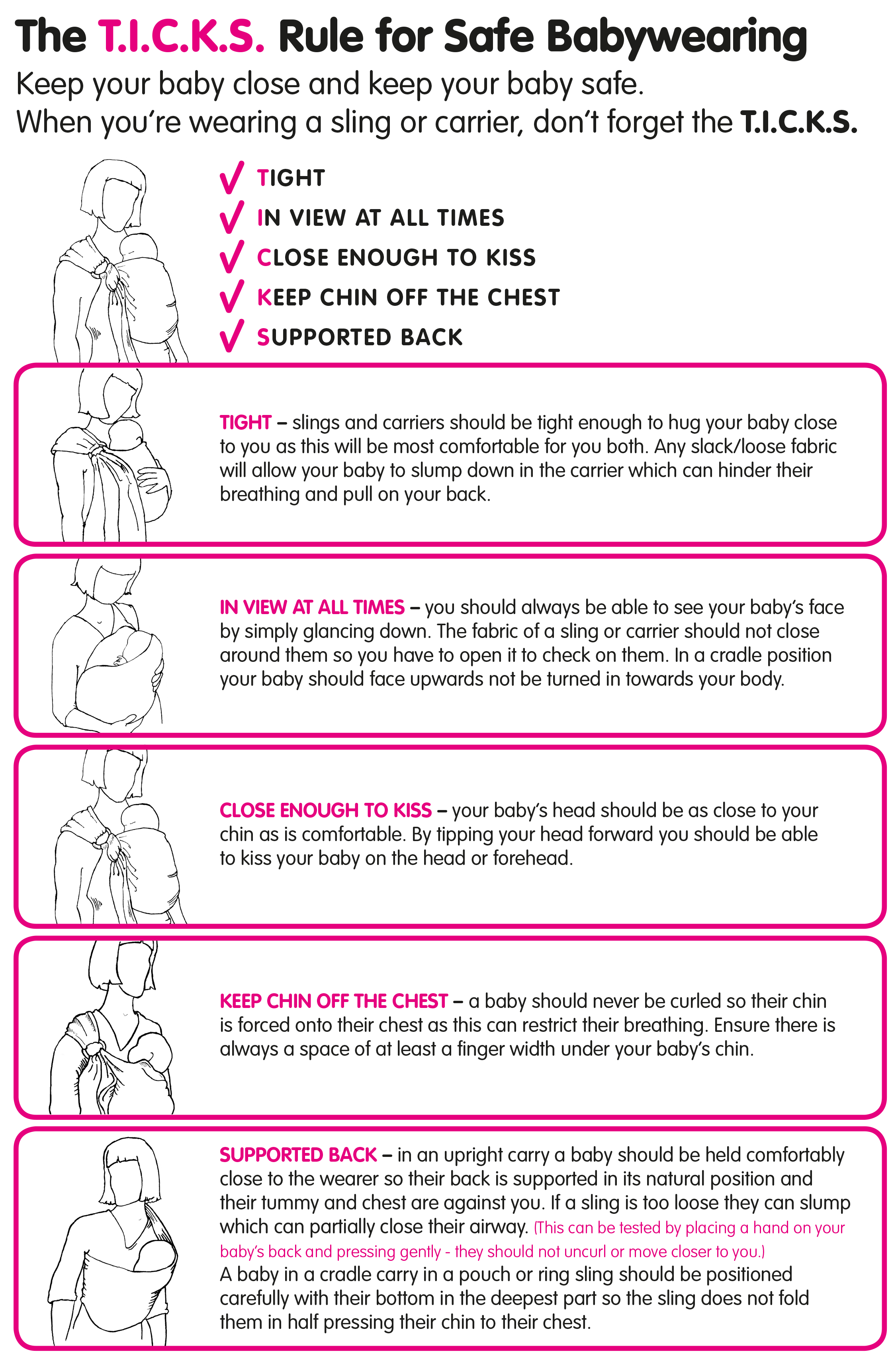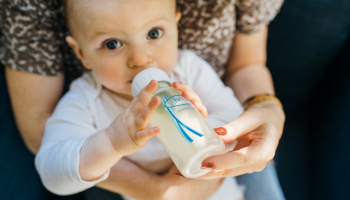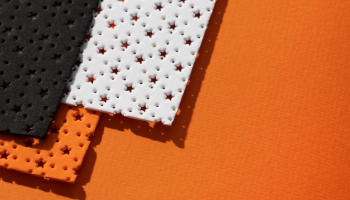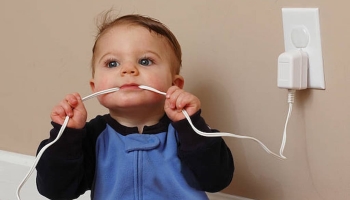Baby carriers are safe, comfortable and convenient – provided that you pick the right one and use it properly. This question-and-answer guide will tell you everything you need to know.
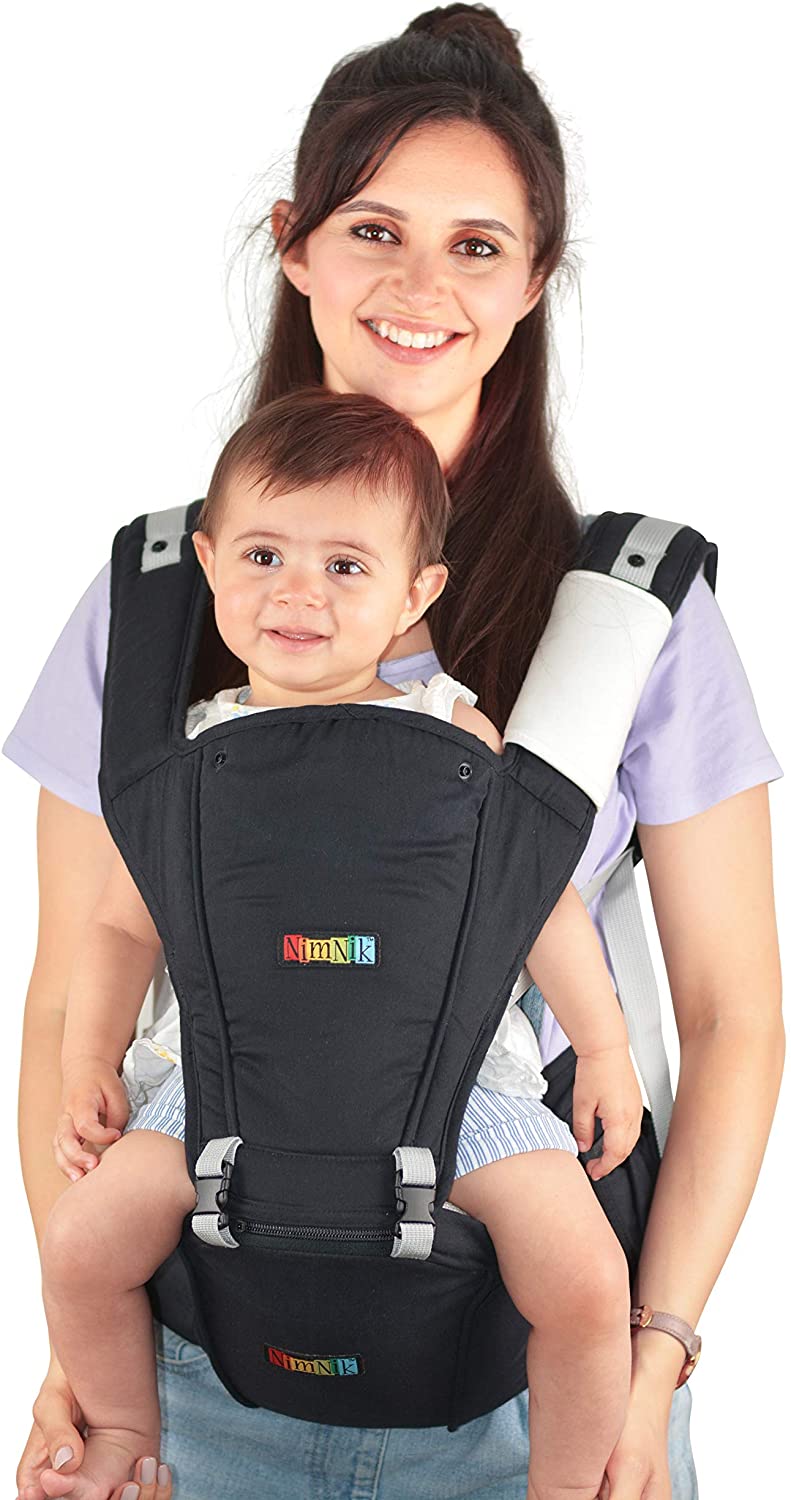 What age can you use a baby carrier?
What age can you use a baby carrier?
You can use a baby carrier from birth as long as your baby weighs at least 3Kg (7lbs).
What are the pros and cons of carriers?
The main advantages of carriers are:
They can be much more affordable than prams and pushchairs
They are much more manoeuvrable than prams and pushchairs
They don’t need any space in cars or public transport
The main disadvantages of carriers are:
Your baby’s weight is all on you
You may find it difficult to walk for long periods or to perform common tasks
You may find them very hot, even in winter
Are baby carriers safe?
Yes, if you use them properly. The most important point is to get your baby into the right position so that they are properly supported and have all their joints (especially their hips) in the right place.
You also need to remember that your baby will pick up your body heat and think about what this means for how you dress them, especially in summer. Keep checking their temperature at the nape of their neck (not in the arm or leg).
Conversely, you will also pick up on your baby’s body heat so think about what that means for how you will dress. When the weather is hot, keep plenty of water with you just in case either of you does overheat (this is a good idea in any case).
What safety precautions should you take?
When you get your baby carrier, practice using it before you put the baby in it. A doll can be helpful here. Some types of carrier do need a bit of practice for parents to feel really comfortable putting them on and taking them off. When you’re using a carrier for real, always make sure that you fasten any fastenings (whatever they are), even if you’re “just popping out for five minutes”.
Check your carrier when you get it to make sure that it is without damage. Even if it’s new, mistakes can happen and you want to find them before you put your baby in. As you use it, check it regularly for damage such as tears, holes and fastenings coming loose. Many of these issues can be fixed, but only if you notice them.
Keep track of your baby’s height and weight and be ready to change out your carrier before they outgrow its safe limits.
When you’re using the carrier, be careful what you eat and drink. It’s best to avoid hot food and drink altogether. If, however, you are too hungry or thirsty to wait, try to stand still (or sit) and turn your head to the side. If you’re drinking (or having soup) try to use a keep cup to avoid splashes (and help the environment too).
Always wear shoes you can walk in safely and comfortably (even if you are going for a formal evening out). Pay attention to your body and to your environment. Remember, if you fall then your baby goes down with you. This should not put you off using a carrier, babies can tip out of prams and pushchairs. It should just act as a reminder that you have a delicate passenger on board and it’s your job to keep them safe.
In particular, pay attention to any signs of fatigue and act on them. Also, look out for tripping hazards and avoid them if possible or, if that’s not possible, (e.g. stairs) tackle them with care.
Can I sit while wearing a baby carrier?
Yes, but your baby needs to stay upright so you can’t lie down.
How do you bend down when using a baby carrier?
Never bend your back or you’ll put your baby at risk of falling out (and yourself at risk of back strain). Bend from the knees (which you should be doing anyway).
What is the correct way to wear a baby carrier?
That depends on your baby’s developmental stage. At birth, you can carry your baby on your front, facing inwards. You need to make sure that their neck is fully supported and their chin is off your chest so that their airway is always open. For the comfort and safety of both baby and carer, you want your baby to be close to your body and high up on your torso. The rule of thumb is that you should be able to kiss your baby’s head.
As soon as they can support their own head (four to six months), you can look at alternative options. Many parents like to carry their child on their front but facing outwards so they see more of the world.
There is, however, some controversy over this as some people believe it is less comfortable for both parent and child. In particular, there are concerns that the baby’s legs just dangle rather than being supported.
While this is a valid concern, babies should only be carried facing front when they can support their head, i.e. from four to six months. By this point, especially at the latter end, their hips and ligaments will have developed, hence the risk of hip problems should be lower, especially if they are only carried for relatively short periods.
More active babies, however, might be better on your hip or even on your back. Older babies and toddlers will probably be far more comfortable on your back and it will definitely be easier for you to manage their weight.
Regardless of your choice of position, you want your baby to be seated comfortably and ergonomically. This means that the middle of their body should be in the middle of the seat (rather than on one side) with their legs open, their hips and knees bent and their knees above their bottom (or at least level with their hips). Some people call this the “frog position”. It may not look comfortable but it is.
What kinds of baby carriers are there?
There are all kinds of baby carriers on the market. Common options include wraps, slings, soft-structured (buckle), Meh Dai/Mei Tai, and backpack baby carriers. You can also get some baby carriers specifically for carrying your baby on your hip. These are, however, not very common.
Wraps
Wraps are exactly what they sound like. They are long pieces of woven or stretchy fabric, which you tie around your body. In principle, wraps can be used from birth to toddler stage. In practice, most parents are really only likely to find them practical for younger (lighter) babies.
Wraps can take a bit of practice to use since you literally have to tie them on the right way instead of just doing up a buckle or tie. On the other hand, they tend to be very affordable and portable. This can make them a great choice if you want to have the flexibility to swap between a pram and a carrier.
Slings
Baby slings carriers come in two forms. These are pouch slings and ring slings. Pouch slings are made of a single piece of fabric, shaped in a loop, with a pouch to hold the baby. You put them over your head and wear them like a sash. Ring slings are made of a long strip of fabric with a pouch to hold the baby and two rings. You feed one end of the fabric through the rings and tie it off to create a sash.
Pouch slings are not very popular because they need to be sized to fit both the baby and the carer. This often means that the parents each need their own sling to carry baby and then this needs to be changed out as the baby grows. Ring slings, by contrast, can be sized and hence shared, plus they last for longer.
In principle, you can use a sling from birth to the toddler stage. In practice, as with wraps, carrying baby in sling is only likely to be comfortable when they are still fairly light. Unlike wraps, however, it’s generally very obvious how to use the baby sling. There is, however, one point which might trip up new parents and it is that some slings support breastfeeding while others don’t. This means that you always need to check.
Soft-structured (buckle) carriers
These days, this is probably what people mean when they talk about using a carrier. It’s essentially a rucksack for a baby, except it’s worn at the front. There’s a pouch supported by two shoulder straps and a waist strap, all of which are adjustable and usually fasten with side-release buckles.
This is generally the most expensive option but there is zero learning curve, it’s easy to share and many models let you change the carrying position as the baby grows. So, for example, you could go from front facing in, to front facing out, to the hip.
Meh Dai/Mei Tai
This is basically the same idea as a soft-structured carrier, but it’s made entirely out of fabric and has ties instead of buckles. This might make it a bit more flexible, but it also means that it generally takes a bit of practice to learn how to put it on properly.
Backpacks
These are exactly what they sound like. They are great for older, heavier, babies and toddlers as you not only have the weight on your back, but you have much more freedom to move your arms. Just remember that if you want a backpack carrier to make it easier for you to participate in outdoor activities, it’s important to choose one which is up to the job.
Choosing the right baby carrier for your baby
There are three many factors that determine the quality of a baby carrier. These are comfort, usability and functionality.
Comfort
Comfort is closely tied to ergonomics. For both the baby and the parents, that means having the baby in the right position with the right level of support.
From the baby’s perspective, it’s vital to have a wide seat so that they feel like they’re in the carrier rather than on the carrier or, worse still, that the carrier is cutting into them. Your little one will also appreciate plenty of padding, breathable fabric and maybe a privacy hood for when the world is getting a bit too hectic for them.
From a parent’s perspective, comfort is generally about adjustability (for that perfect fit), padding and the ability to position the baby to get as much weight as possible onto your back.
Usability
This is partly a matter of taste, partly a matter of lifestyle and partly a matter of construction quality. If you intend to carry your baby in a wrap, sling or Meh Dai/Mei Tai, then you should expect there to be a bit of a learning curve, especially with wraps. You should not, however, have to spend hours having to figure it out.
Once you’ve grasped the basic mechanics, then you should be able to carry your baby, with most, if not all, of the weight on your back, without any hassle whatsoever. If you can’t then there’s something wrong. Either you have misunderstood the instructions, or your baby has outgrown it, or you have unfortunately chosen a low-quality carrier. To avoid the last pitfall, do your research thoroughly before you buy.
Functionality
Think about how you will carry your little one and what that means in terms of functionality.
For example, if you’ve decided that you just want to carry a newborn close to you over the “fourth trimester” and nothing else, then a basic wrap or ring sling may offer the best overall value for money.
Similarly, if you just want to carry your little one from time to time then it might make sense to go for a wrap or sling as the most budget-friendly option.
If, however, you’re sure you want one carrier to carry a baby from newborn to toddler, then you probably want to invest in a soft-structured carrier.
Whatever option you choose, remember that anything which comes into close contact with a baby needs to be easy to clean.
